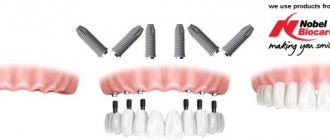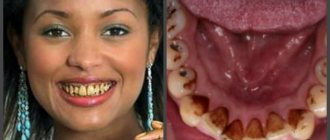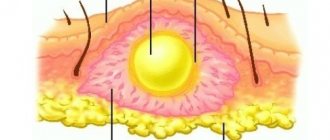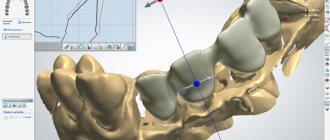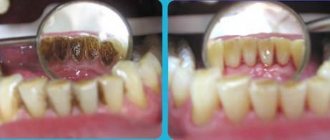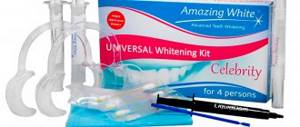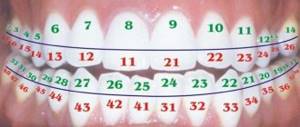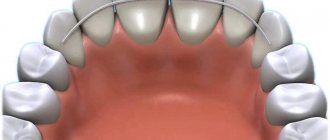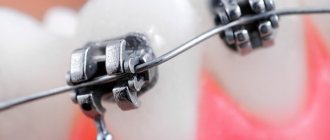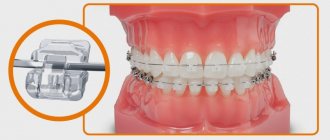The success of dental implantation consists of two main components - high-quality materials and the professional work of the doctor. In most cases, both of these factors go hand in hand, because if dentistry cares about improving the qualifications of its specialists, then it chooses implant manufacturers with the utmost care. Today, Nobel Biocare is considered one of the most popular brands in the industry. Nobel Biocare dental implants have been used all over the world for over 40 years and have a well-deserved reputation as the most reliable and safe. Let's look at why they are good and why they are used by the best world-famous clinics, together with the implant surgeon at Ilatan Dentistry in Moscow Berdzenadze Zurab Zaurievich.
Manufacturer NobelBiocare LLC (Sweden)
Nobel Biocare has been developing and producing titanium denture bases for several decades. It is the undisputed leader in the international market of innovative technologies in the field of dental implantology and aesthetic dentistry.
The history of the enterprise dates back to 1981. Then it was called Nobelpharma . The current name Nobel Biocare was assigned in 1996. The concern is part of the global scientific and technical corporation Danaher , whose goal is to provide real ways to solve complex problems, thereby improving the quality of life of many people around the world. The company's main office is located in Washington (USA) and consists of a multinational team with a total of 71 thousand employees. Production workshops operate in many technologically developed countries of the world: Sweden, Switzerland, Japan, Israel and others.
Reliable connection (without gaps) between implant and abutment to achieve long-lasting functional and aesthetic results
Nobel Biocare Implant System
Nobel dental implants are made of titanium using vacuum casting, so they are strong, but lightweight and do not create unnecessary stress on the jaw. The Nobel Biocare system is designed to ensure the fastest possible engraftment, even when it comes to single-stage implantation. Bone cells do not recognize a foreign body due to the porous titanium dioxide surface, so the chance of rejection of such a rod is about 0.7%.
Nobel Biocare cares about its reputation: all stages of production, starting with the purchase of material, undergo strict control and meet certified standards of the American Dental Association (ADA). The company provides a lifetime guarantee for all its implants, and each product receives its own individual number to avoid counterfeiting. Reviews from patients about the quality of Nobel implants allow us to form the most objective opinion.
The only drawback of the system is the price. Dental implantation by Nobel Biocare, as they say, “costs a pretty penny,” but in the long term, such treatment turns out to be cost-effective. High-quality installation of Nobel Biocare implants is done once and for almost a lifetime, while correcting work done using low-quality materials will be much more expensive.
Development and production process of Nobel Replace
The work process is in constant dynamics, in search of new modern solutions. Improving implants, materials, equipment, technologies are the most important priorities. Our own patented developments are the result of many years of scientific activity. The effectiveness of the products is confirmed by documented data from more than 200 studies. In addition to the structures themselves, the manufacturer offers everything necessary to work with them: training of specialists, its own 3D diagnostic and planning system, orthopedic and surgical kits, and components.
Nobel Biocare has created reliable protection for its products against counterfeiting. Each product has a serial number.
You can check its originality on the company's official website. In addition, implants come with a lifetime warranty and are only installed by certified dentists.
Product catalog produced by the company
The Nobel Replace line includes several unique titanium root models and abutments.
Implants
Nobel Replace Groovy
It is a root-shaped rod with a polished neck and a connection for an abutment in the form of a trihedron. It has reliable stability, which makes it possible to instantly load and reduce the adaptation period. Deep thread ensures the most durable fixation. Indications for use include almost all cases of edentia .
Nobel Replace Select
One of the first models in the series. The design of the implant is similar to Nobel Replace Groovy, but unlike it, it has a more refined body (in the neck area the diameter is 1.5-2 mm). Designed for special cases when it is necessary to quickly achieve high levels of aesthetics. Used for express and one-stage operations .
The design allows you to adjust the depth of screwing in order to correctly form the gingival margin. The special TiUnit surface promotes rapid osseointegration and bone regeneration. Due to its versatility, the system is quite common in many dental clinics around the world.
Nobel Replace Tapered + Select Tapered
A popular system that combines two models of root-shaped implants. It is characterized by a high level of primary stabilization and is suitable for installation in the socket of a newly extracted tooth. Allows instant loading. Reliable and precise fixation of the abutment is ensured thanks to a special connection equipped with three anti-rotation channels. The four types of implant presented in the series help solve any clinical situation.
Model range of titanium implants
Conical Connection (Nobel CC)
The design of Konikal titanium pins is similar to Groovy. Only the types of connections differ between models. The triangular system was replaced by a hexagonal one with a cone. This difference provided a more reliable connection. To achieve maximum aesthetic results, the doctor has 6 different abutment positions at his disposal. Conical implants are used in one-stage and two-stage implantation , as well as in cases of insufficient bone tissue density.
Branemark (Branmark systems)
A universal version equipped with a hexagonal fastening type. The last thread of the product is located almost near the neck, which helps to improve fusion with the edge of the bone. The system is still at the stage of research and improvement .
Speedy
The implant is specially designed to quickly restore missing teeth . Perfectly osseointegrates into low and medium density bone tissue. The design is suitable for the All-on-4 technique. A reliable connection to the abutment guarantees a tight installation of the prosthesis. Strong fixation of the pin in the jaw is achieved thanks to the deep thread, which is typical for Speedy models.
Guide
The most gentle model. Provides minimal surgical intervention during implantation. The peculiarity of the installation is that there is no need to make an incision in the gums and apply sutures. Thus, trauma to the jaw tissue is reduced to zero , and the rehabilitation process is significantly accelerated.
Nobel Active
The system has a wide range of indications for use. Not only implantologists, but also orthopedic dentists and prosthetists participated in its development. It is installed using the “All-on-4” technique, which reduces the load on the bone by attaching the entire row to four implants. This is most relevant for serious problems with bone tissue. The cone-shaped titanium rod has good stabilization. Double thread makes screwing easier. It is used in a wide variety of clinical cases .
Implants of the Nobel Replace series are widely used in many countries around the world. They are united by excellent quality, reliability, strength and durability.
If we compare Nobel Replace Select with other models in the series, they are the only ones with a special, sophisticated body. This makes them indispensable when it is necessary to obtain a quick aesthetic result.
Abutments
In addition to implantation systems, the manufacturer offers a large selection of permanent and temporary abutments. All of them are manufactured using the latest technologies and are able to satisfy any functional and aesthetic requirements. Available in titanium, zirconium dioxide and gold alloy . The materials are characterized by excellent tissue biocompatibility properties.
Nobel implantation system: strengths
The most important factor on which the speed and quality of osseointegration (fusion of the implant with the bone) depends is the characteristics of the surface of the dental implant. Budget manufacturers can easily copy their best implants from top-end ones, for example, the shape or nature of the thread. But it is technologically impossible to take and copy the surface of an implant, and therefore there are very few dental implants with really very good surfaces.
Nobel Biocare implants have a really high-quality surface called Ti-Unite ® (Fig. 2-3). Objectively, it is worth saying that this is one of the best surfaces on the implant market - along with the SLActive® surface for Straumann implants, as well as the OsseoSpeed® surface for Astra Tech implants. By the way, another plus is that Nobel uses for production only the more expensive pure titanium class 4 (G4Ti) without vanadium or aluminum impurities. Titanium alloys with these impurities are used for the production of budget implants, but their disadvantage is that they somewhat slow down the process of osseointegration.
The TiUnite® surface has the following properties –
The TiUnite® surface is a thickened layer of titanium dioxide with a moderate degree of roughness. One of its features is the high content of phosphorus, which is applied to the surface during the process of anodizing it. Anodizing is a complex electrochemical process in which the implant is immersed in an electrolyte and exposed to current. Anodizing leads to an increase in the number of micropores, an increase in the thickness of the oxide layer, and allows phosphorus to be applied to the surface.
TiUnite® surface under a microscope –
Anodizing (anodic oxidation) provides many advantages. For example, it allows you to create a thicker layer of titanium oxide on the surface of implants, which improves biocompatibility. In addition, during the technological processing, the surface of the implants receives a negative charge, which gives the surface increased hydrophilic properties. The latter ensures faster adsorption of blood plasma proteins on the surface of the implant (for example, fibronectin and thrombin), which leads to a faster release of growth factors from platelets, and as a result, to a faster onset of osseointegration.
A high phosphorus content is also of great importance because... it has a positive effect on the stability of the implant. Primary stability of the implant (immediately after its insertion into the prepared bone bed) is one of the key factors for normal osseointegration. The significance of this factor is greater the earlier the load on the implant is planned, i.e. prosthetics. But stability can be not only primary, but also secondary.
The fact is that immediately after installation of the implant, the process of traumatic bone resorption begins around it. Its duration will depend on the technique of preparing the bone bed, on the design of the thread and other characteristics of the implant surface (and can last up to 2-3 weeks). The stability of the implant during this period can be called “secondary stability”, and it will always be worse than the primary one. So, a high phosphorus content allows you to shorten the period of traumatic resorption, thereby improving the secondary stability of the implant.
Important: Accordingly, the Ti-Unite® surface allows to accelerate the process of osseointegration, as well as improve the stability of the implant (which is very important if immediate or early loading is applied). Immediate loading means fixation of the artificial crown immediately after surgery, and early loading means fixation of the crown in the first 3-5 weeks after surgery. Such early prosthetics always creates certain risks, and therefore requires a more careful approach to the choice of implants.
Another advantage of the Ti-Unite® surface appears when installing Nobel implants in an area with insufficient bone volume (i.e., when there is a need for simultaneous bone grafting). The fact is that the effectiveness of filling bone defects near the implant very much depends not only on the quality of the implanted bone material, but also on the characteristics of the surface of the dental implant (which will act as one of the walls of the bone defect).
Nobel implantation: video of operation
I would like to say that the reviews for Nobel Biocare implants are generally very good, but there are some nuances in choosing certain models of implants from this company - depending on the clinical situation and the type of bone tissue. If the implant surgeon follows the treatment protocols, you will certainly get a good result even in difficult situations, for example, in areas with insufficient bone volume, as well as in conditions of immediate loading (immediate prosthetics).
How Nobel Replace differs from its analogues
The implants of the Nobel Replace series stand out against the background of analogues:
- versatility;
- possibility of installation using different methods: one-stage, two-stage, express, “all on four”;
- reliable fixation in the jaw due to threads applied over almost the entire surface of the rod;
- sealed connection with the abutment;
- unique TiUnite coating, providing a high level of initial stability and a rapid healing process;
- ease of use;
- the presence of a wide range of prostheses for fixation on implants of this line;
- speed of implantation;
- lifetime warranty from the manufacturer.
Special TiUnite coating
The surface of TiUnite implants is a patented development of the company. More than 10 years of clinical studies have proven the effectiveness of the coating. The manufacturer was not trying to develop a profitable product, but was studying the properties of bone and the principles of integration with the implant material in order to make implantation faster and painless for patients. This led to the creation of TiUnite coating. The porous surface literally allows bone to pass through, allowing it to grow into the structure as it integrates. The use of technology ensures a high success rate of treatment and, most importantly, the absence of health problems in the future.
Indications and contraindications for implantation
The use of Nobel Replace implants is indicated in the following clinical situations :
- partial and complete edentia;
- absence of a tooth for a long time;
- low bone density and volume deficiency;
- the need to restore the aesthetic appearance of the smile as quickly as possible.
It is not recommended to install rods from Nobel Biocar Replace if:
- there is an individual intolerance to one of the components of the system;
- allergic reaction to medications used during surgery;
- inflammatory processes in the oral mucosa were detected;
- diseases of teeth and gums (until they are relieved).
Unless absolutely necessary, implantation should not be performed in pregnant women.
Advantages and disadvantages of the system
The undeniable advantages of Nobel Replace designs are:
- biocompatible coating similar to the structure of the jaw bone tissue;
- almost zero risk of rejection;
- this is an ideal option for aesthetic prosthetics using zirconium crowns;
- complete restoration of chewing function;
- a large assortment of rods of varying shapes and sizes;
- solve most of the most complex clinical cases;
- the presence of various modifications of abutments allows prosthetics to be performed at the highest level;
- atraumatic implantation process;
- protection against counterfeiting.
The implant is ideal for immediate loading due to its high primary stabilization
Speaking of disadvantages , it should be noted that Nobel products are expensive.
Not every patient can afford to purchase it.
Preparation for surgery, installation of the implant and its service life
Dental implantation is a rather complex procedure that requires certain preparation.
Before the operation, the doctor carries out a number of activities, including:
- examination of the patient for pathologies that can lead to complications (poor blood clotting, AIDS, diabetes mellitus and others);
- sanitation of the oral cavity;
- radiography;
- if necessary, bone tissue augmentation;
- creation of a 3D layout.
Implantation using Nobel Replace systems is performed using several methods.
In a one-step procedure :
- Introduction of anesthetic.
- Gum incision.
- Formation of a bed in the bone.
- Screwing the rod.
- Installation of abutment.
- The crown is put on.
How does two-stage implantation differ from this method?
- Anesthesia.
- Preparing the site for the pin and its implantation.
- Closing with a plug screw.
- Stitching.
- After 4-6 months, the gum former is fixed.
- After two weeks, replace with an abutment.
It is worth noting that to install the former, the mucous membrane is again incised and sutures are applied.
The lifespan of implants from the Nobel Replace line is unlimited, provided that the implantation technique and proper use are followed.
Standard and quality assurance
Each implant comes with a lifetime guarantee.
The highest quality of Nobel products is confirmed by international certificates. Each model complies with ISO medical device standards . When purchasing a system, the patient receives the appropriate documentation, including a quality certificate. Products are tested at all stages of production. The company's employees constantly consult implantologists from different countries, which contributes to the growth of the effectiveness and safety of treatment.
Another confirmation of the absolute quality of Nobel Biocar implants and components is an extensive warranty program that provides for various cases that require free replacement of components. Thus, in case of rejection that occurred through no fault of the doctor or the patient, an absolutely identical kit is provided. Additionally, the manufacturer offers replacement for implants of other brands that have been installed with Nobel Biocare elements.
Each artificial root comes with a lifetime warranty, and the abutment comes with a ten-year warranty.
Nobel implants: reviews and key characteristics
As we said above, the most popular among implantologists are Nobel implants with a conical connection. Reviews from implantologists show that it is around implants with a conical connection that there is a minimal decrease in the height of bone tissue (from 0.5 to 1.0 mm), which naturally occurs during the first year from the moment of prosthetics. Below we will talk about each of the wide range of Nobel implants -
- "Nobel-Active"
- "Nobel-Parallel CC"
- "Nobel-Replace CC"
- "Nobel-Replace Select"
- Branemark system implants,
- "Nobel-Speedy"
- "Nobel-Zygoma".
1) Nobel-Parallel CC implant –
The author of this review (from the entire line of Nobel Biocare implants) – this implant is probably the most favorite. This is a universal implant for all types of bone in the upper and lower jaw, having parallel walls and a conical connection. In addition, it is an excellent choice for the All-on-4 implantation technique (i.e. for immediate loading in completely missing teeth).
Why is this implant so good? One of the big problems with implantation in the lower jaw is the insufficient width of the alveolar process. What this implant does in this case is that it works like an osteotome. When we insert the tip of the “Nobel-Parallel CC” into the cancellous bone and continue to screw it in, the implant begins to push the bone tissue apart, thereby expanding the alveolar process. In some cases, this may allow us to do without mandatory bone grafting.
In soft types of bone (on the upper jaw), this implant will no longer be able to move the bone tissue apart, but will slightly compact it. This will allow us to get good primary stability. Moreover, thanks to the apical design, i.e. the presence of special grooves on the tip - when installing this implant, we can use a bicortical type of fixation. This type of fixation further enhances primary stability, which is again important in soft bone conditions in the maxilla (especially when we need immediate crown/denture loading).
“Nobel-Parallel CC” also has a special ledge in the neck area, which allows you to form a sufficient volume of soft gum tissue in the neck area, which, accordingly, will allow you to achieve good aesthetics in the area of adjacent gum to the implant. Well, thanks to the conical connection - 1) we will not get significant bone resorption around the neck of the implant, which could negatively affect the aesthetics of the gums, 2) reliability increases and the risk of developing peri-implantitis decreases (24stoma.ru).
2) Nobel Active implant –
The Nobel-Active implant is positioned for her as “a unique implant that has no analogues” (Fig. 4).
This is in some way true - thanks to the presence of an inverted cone shape in the neck area, which helps preserve the volume of bone and soft tissue of the gums (including the volume of the gingival papillae) - over a very long period of operation of the implant. "Nobel-Active" is the most expensive implant in the Nobel line. The purchase price of 1 such implant for the clinic is from $390 (and this does not even include the cost of the abutment). The results of clinical studies show that the survival rate of these implants over 8-10 years of operation has the following indicators - about 98% in the lower jaw, 96% in the upper jaw. If we take the survival rate of these implants when using an immediate loading protocol (i.e. when the crown is installed immediately after surgery), the figure is about 95.7%.
The Nobel Biocare company calls the Nobel-Active implant its best implant, so we will dwell in more detail on its pros and cons. If you are only interested in positive reviews of Nobel implants, the official website is nobelbiocare.com/ru. But there you will find mostly only advertising theses.
Key features (according to the manufacturer) –
1) Nobel-Active implants are aggressively threaded, which gives us several advantages. Firstly, it provides very high primary stability in all types of bone (even in soft bone types D3 and D4), as well as when installed in fresh sockets of extracted teeth. And this allows us to use immediate load more often. Secondly, such an aggressive thread allows the implantologist to change the direction of screwing the implant at any time (right during the process of screwing it into the bone bed), which in some cases may be really necessary.
2)
One of the features of this implant is a reverse-conical neck in the upper third (Fig. 5), which provides a low load on the cortical plate of the bone. This contributes to maximum preservation of bone tissue around the neck of the implant - during a very long period of its functioning. This also ensures a good volume of soft gum tissue around the implant neck (for example, the volume of gingival papillae), and as a result, good aesthetics in the area where the gum adheres to the implant.
3) The Nobel-Active line has an implant with a diameter of only 3.0 mm, which allows it to be installed in narrow spaces, for example, with a small gap between teeth, as well as with a small width of the alveolar ridge (which in some cases helps to avoid mandatory bone grafting or at least This will reduce its volume as much as possible). On the other hand, for prosthetics in the area of lateral chewing teeth, there are Nobel-Active implants with a wide platform, which will create an ideal gum contour.
Clinical case of using Nobel-Active (Fig. 6-7) –
Reviews of implantologists in the USA and Europe about NobelActive –
1) The main advantage of the NobelActive implant is its high primary stability in the bone immediately after installation, which allows you to immediately manufacture and install a temporary artificial crown on it. However, 90% of implant surgeons say that in the next couple of weeks (during the period of traumatic bone resorption) the stability of the implant noticeably decreases, and therefore there is no need to overuse the immediate load.
It is still optimal to use the early load protocol, i.e. when loading the implant with a crown is carried out within 3-5 weeks after surgery. And I would also like to add that a longer period of traumatic bone resorption in NobelActive is observed precisely due to the aggressive thread, which, when screwing in the implant, unnecessarily injures the bone trabeculae.
2) NobelActive is recommended (bone types D3-D4). This recommendation practically excludes its use in the lower jaw, where hard bone types 1-2 predominate. If you look at the Nobel Biocare clinical study published by the company in January/February 2010, this study on NobelActive actually does not have very good radiographs of long-term results - when using these implants in the lower jaw.
3) This is an implant for experienced implantologists. The aggressive thread profile allows the implantologist to change the direction of screwing in the implant even in the middle of the installation process. It is a big plus when the implant surgeon is experienced. But many implantologists say that “the implant goes where it wants” - after all, the bone tissue is not homogeneous in structure, and the implant tends to areas of the lowest density, independently changing direction. As a result, the implant very often ends up in a position that was not intended.
An attempt to remove the implant a little and reinstall it in a slightly different direction leads to the fact that the implant will simply dangle in the bone without any primary stability. Therefore, it is better to trust this implant to be installed only by implantologists with extensive experience, and only in areas of the jaws where the implantologist has good visual and tactile control, and where good aesthetics of attaching the marginal gum to the implant is required (the anterior part of the upper jaw).
Conclusions: The Nobel Active implant is undoubtedly a worthy implant if it is in good hands. When implanted in the upper jaw, it causes virtually no bone atrophy around the neck of the implant (while the normal atrophy rate is 1.5 mm during the first 1.5 years). Thus, this will allow for excellent aesthetics of the gums around the implant neck, which is very important when it comes to implantation in the area of the anterior teeth.
Interesting information -
Few people know that Nobel-Biocar bought the popular Israeli company in 2008. The purchase was due to the fact that at that moment this company patented and released a very interesting implant with an inverted cone neck, which was called “Alpha-Bio SFB” (priced at $90). Nobel Biocare also acquired the patents of this company, and as a result, the production of the SFB implant under the Alpha-Bio brand was discontinued.
After some time, Nobel-Biocar began to produce an almost exact copy of the “SFB” implant, but only with a much more modern TiUnite® surface, calling the implant “NobelActive”. By the way, the cost of the implant immediately became about $390, plus another $62 will need to be paid for the abutment. Fortunately, many other Nobel-Biocare implant models are cheaper.
3) Nobel-Replace CC implant –
This is a fairly good implant, which has a root-like shape (providing it with decent primary stability), a reliable conical connection and a built-in platform change function.
Can be used for immediate crown loading. The presence of a small ledge in the neck area makes it possible to form a sufficient volume of soft tissue to achieve good gum aesthetics, which is especially important when implanting in aesthetically significant areas. Depending on the clinical situation and the required depth of immersion of the implant, it can be supplied with two neck options. The Nobel-Replace SS implant has a regular neck, and the Nobel-Replace SS PMC implant has a milled polished neck of about 75 mm. It must be said that the cost of this implant model will be lower than those listed above.
4) Nobel-Replace Select implants –
This is a rather boring and uninteresting system that is used in very rare clinical situations. In general, there is no point in considering it, let’s just say that it has a planar internal three-channel connection (not very successful, and certainly inferior in all respects to implants with a conical connection).
5) Branemark System implants –
This is a universal implant system (for patients with any bone density), as well as a very wide range of abutments, which allows even the most complex cases to be replaced with implants. Probably, only a wide range of abutments and wide possibilities for prosthetics are their only competitive advantages.
The absolute disadvantage of this system will be the planar external hexagonal connection. Firstly, it is not as reliable and hermetically sealed as a conical one, and secondly, there will always be a much higher degree of bone resorption around the necks of implants with such a connection. For example, the amount of resorption around the necks of implants with a conical connection is only from 0.5 to 1.0 mm (which is a very good indicator), and around the external hexagon - from 2.0 to 2.5 mm.
Price
Prices for Nobel Replace series implants range from 20 to 30 thousand rubles per unit. Necessary components and doctor’s work are paid separately. The cost of the procedure for implanting the structure depends on :
- the selected pin model and installation method;
- clinical picture;
- pricing policy of a medical institution;
- the level of qualifications of the specialists practicing in it.
If a patient is offered to implant the Nobel system at a price lower than average compared to other clinics, one should be wary and doubt the originality of the product. The high cost of Swedish-made implants is justified by the high technology of the production process. You can check the authenticity of the product on the company’s official website using the code printed on the rod.
Nobel Biocare implants: turnkey price
Below you can find the average prices in Moscow for the installation of 1 Nobel implant - for economy class clinics and mid-price clinics. The price for surgical installation of 1 Nobel implant (without prosthetics) in Moscow starts at approximately 50,000 rubles or more, which will depend on the cost of the selected implant model.
Cost of surgical installation of 1 implant:
- Nobel-Parallel CC and Nobel-Replace CC - on average from 50,000 to 60,000 rubles,
- Nobel-Active - from 60,000 to 70,000 rubles, the price is indicated only for the operation and does not take into account the cost of the abutment and crown. However, in a number of clinics during promotional offers the price (for example, for Nobel-Parallel CC) can be reduced to 45,000 rubles.
The cost of the prosthetic stage: this will depend on the type of artificial crown and the type of abutment. For example, the cost of a metal-ceramic crown with a metal abutment will cost an additional 35,000 rubles, and a ceramic crown made of zirconium dioxide, including a zirconium abutment, will cost at least 45,000 rubles. Thus, the turnkey price for Nobel implants (including surgery, abutment and crown) is –
- with a metal-ceramic crown – from 85,000 to 100,000 rubles,
- with a zirconium crown – from 95,000 to 110,000 rubles.

